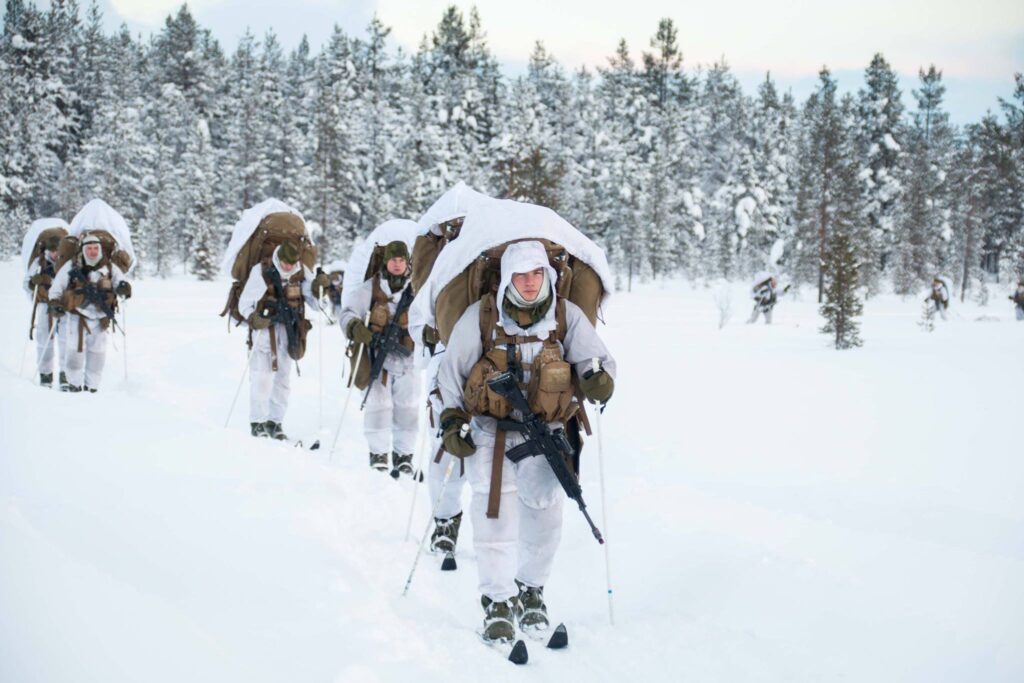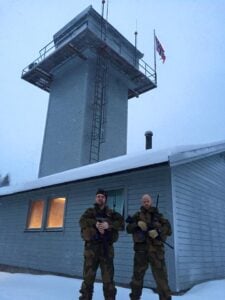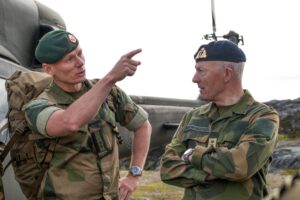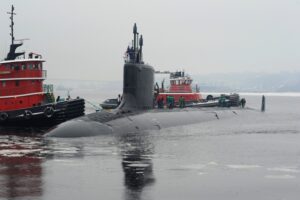
Norwegian soldiers patrol near the Russian border high above the Arctic Circle.
GARRISON SOR-VARANGER, NORWAY: A toxic brown haze blankets the Russian industrial city of Nikel, hiding its Soviet-era smokestacks from our view as Norwegian soldiers manning this watchtower keep their eyes fixed on the border, about a mile away. Every now and again a soldier will point out the black factory towers in the distance as the wind shifts.
Between Nikel and the Bjørnsund observation tower lies a vast, snowy expanse that runs the length of the rugged Pasvik Valley high above the Arctic Circle, where Norway meets Russia along a 125-mile frontier. A string of small towers tucked into the thickly-forested hillsides house a handful of Norwegian troops monitoring what is arguably the most militarized area in the vast Russian interior.
Russia’s Kola Peninsula is home to the prized Northern Fleet and some of Moscow’s most advanced long-range weaponry, assets that can move quickly and without much warning from the high north down the Norwegian coast and into the North Atlantic.

Norwegian soldiers in front of one of their border watchtowers.
The guards here, who spend weeks at a time in these small cabins, watch for any suspicious movements along the valley; they admit things are mostly quiet. But back at the nearby base supporting these outposts, bristling with snowmobiles, all-terrain vehicles, and hundreds of troops ready to push into the rugged Arctic hills if the signal is sent, the reality of the force on the other side of the border weighs heavily.
The Norwegian troops here are fully aware they’re outmanned and outgunned by the thousands of mechanized Russian forces arrayed just over the border. They’ve trained to disperse rapidly and fight what amounts to a spoiling action, using their knowledge of the terrain, Javelin missiles, and small arms to keep the enemy off balance while reinforcements are mobilized.
Officials in Oslo are quick to point out they see little reason for Russia to mount a frontal assault across this jagged landscape, capped by steep hills and sliced by rivers and deep ravines. But they’re also aware that any NATO confrontation with Moscow would almost certainly spill into the strategic Arctic region.
Oslo is under no illusions when it comes to its presence in the high north, however. Multiple officials referenced the troops here as a “trip wire” that would trigger a larger response from Norwegian jets based further south, along with an expected NATO response.
But, as one government official said, in the capital “there is a sentiment that we cannot rely on our allies to do everything.” In response, Norway is doing what it can.
“Russia, without violating borders, can dominate the area using multilayered systems,” base commander Lt. Col Jan Marius Nilsen told me during a visit sponsored by The Atlantic Council last month. The Russians have placed “early warning radars, air-defense, land based missile stations, and other sea and air assets” within minutes of the border fences, Nilsen said. “They can activate this very rapidly. We just need to be present in key areas.”

Lt. Col Jan Marius Nilsen points out positions to Norway’s Chief of Defense Adm. Haakon Bruun-Hanssen during his visit to the Arctic outpost.
His concern was starkly illustrated this past weekend, when Russian news agencies reported a Kola-based MiG-31K test fired a Kh-47M2 Kinzhal ballistic missile nearby. The nuclear-capable missile, derived from the ground-launched Iskander-M, was one of the six new weapons President Putin boasted of during his infamous sabre-rattling March 2018 speech. The range of the missile, somewhere between 900 and 1,200 miles, puts all of Norway well within its sights.
The key areas Nilsen mentioned are spread out along the Norwegian high north, and the five infantry companies under his command take turns rotating between a series of small observation posts along Norway’s 125-mile border with Russia. The troops, mostly conscripts, are bolstered by a seasoned Ranger company and soon, specially-trained troops known as JTACs (Joint Terminal Attack Controllers) capable of calling in precision airstrikes from NATO aircraft.
“Norway has an exclusive and outsized role in NATO’s deterrence posture in the High North,” said the Atlantic Council’s Chris Skaluba, who worked on NATO and European policy at the Pentagon until recently. But the light military posture Norway keeps on the Russian border “is a signal to Russia that Norway (and therefore NATO) does not expect tension or hostilities” in the region, he added.
While the Norwegian government has made a decision not to overly militarize the border, Oslo has a ready force in reserve in the form of the Home Guard, a 40,000-strong civilian militia ready to spring into action if the balloon goes up. Visitors get few details, but the locals around the Finnmark region and the Norwegian town of Kirkenes would act as a guerrilla force, using local contacts and their knowledge of the terrain to harass a Russian force, blowing bridges and sabotaging roads.
The scenario is something the garrison trains for regularly. Looking at the Russian invasion of Ukraine, where they use electronic jamming to blind Ukrainian forces and turn off their ability to communicate, Nilsen said in a fight, “potentially I will not have comms, so I need to use small unit tactics and disperse, and I have to act differently from other units.”
Home Guard also has a partnership with the Minnesota National Guard that stretches back to 1974, when Home Guard troops began traveling to Minnesota to train with US guardsmen, with Minnesota guardsmen traveling to Norway each year to train. (Hundreds of thousands of Minnesotans claim Norwegian ancestry, and ties between Norway and the state are close.)
While there is no significant ethnic Russian population here for Moscow to help feed disinformation and stir discontent, shops in Kirkenes heavily rely on Russians crossing the border to buy goods they can’t get at home, local officials say. And the local Norwegians and the Russians share a unique history dating back to the Second World War.
In 1944 the Red Army fought a bloody battle to to push German troops out of the town, and they were greeted as liberators by the locals who hated their Nazi occupiers. Unlike Eastern Europe, where the Soviets set up their own repressive regimes dependent on Moscow, the Red Army actually went home at the end of the fight, a withdrawal that is warmly remembered here and celebrated each October.
This year, Norway’s royal family, along with Prime Minister Erna Solberg. Foreign Minister Ine Søreide, and Chief of Defense Adm. Haakon Bruun-Hanssen met with Russian Foreign Minister Sergi Lavrov and Northern Fleet Commander Vice Adm. Aleksandr Moiseyev to mark the 75th anniversary of the 1944 battle. The unique relationship is something that Olso has to keep in mind when dealing with the region, and protecting its border.
The arrival of JTACS next year will provide some cover for both the base and the border outposts dotted amid the valleys and heavily forested hilltops along the border. The border is generally quiet, soldiers at one outpost told me, and the Russian border guards — controlled by Moscow’s FSB spy agency — also have their eyes more closely trained on the Russian interior, as opposed to peering into Norway.
Just over the border sits the Russian 200th Motor Rifle Brigade, which has experience in Ukraine and fields dozens of tanks and Grad rocket launchers, and the 61st Naval Infantry Brigade, which consists of veterans from Ukraine and Syria. One Norwegian official called the units “highly trained and potent Russian forces” that can move quickly and strike from the ground, sea, and air.
The powerful Russian Northern Fleet is also headquartered nearby, and flexed its muscles in late October when it pushed 10 submarines into the North Atlantic where they conducted live fire tests while playing a game of cat-and-mouse with US and NATO subs and sub-hunting aircraft.
The military power coiled on the peninsula led one US observer who works on these issues and asked to speak anonymously to suggest that, despite all of the concern over the militarization of the Arctic region, the issue is actually far more localized: “NATO has a Kola Peninsula problem rather than an Arctic problem.”
The activity this fall in and around Norway is notable. The day before my visit to Garrison Sor-Varanger, three US B-52 bombers skirted the Norwegian coast accompanied by several Norwegian F-16s from the Bodo Air Station, in a show of force that’s becoming increasingly common.

USS Minnesota
The public US muscle flexing demonstrations were hardly over. On Nov. 21, the US 6th Fleet tweeted photos showing MK-48 Advanced Capability torpedos being loaded aboard the USS Minnesota, a nuclear-powered fast attack submarine, at Haakonsvern Naval Base on Norway’s west coast. Prodding Moscow, the service wrote that “many thought 1xUSsub was tracking #Russian activity. Not so fast! There were TWO (maybe more).”
On Nov. 26, the 6th Fleet then promoted a port visit by the guided-missile destroyer USS Gridley in Tromso, Norway before it participated in a multinational exercise off the Norwegian coast
The Northern Fleet’s big show validates Oslo’s recent purchase of five P-8 aircraft, officials here said, and underscores the need for more anti-submarine technologies on surface ships and helicopters. Defense Minister Frank Bakke Jensen earlier this year announced that he is working on a significantly larger and more ambitious budget plan set to be submitted to Parliament in the spring that includes growing the end strength of the armed forces, adding five new submarines — one more then currently planned — and increases in the number of medium and short-range air defenses, a key technology that could make a major difference in the high north.
Overall, Adm. Bruun-Hanssen has said he needs about $2.7 billion more by 2028 in order to meet modernization goals, or about $300 million more per year. The 2020 defense budget is about $6.6 billion, placing Norway, for the moment, under the NATO goal of spending 2 percent of GDP on defense, a goal still some time off, even with the planned spending increases.
Sullivan: Defense industry ‘still underestimating’ global need for munitions
National Security Advisor Jake Sullivan said that there are “no plans” for another Ukraine supplemental at this point.


























